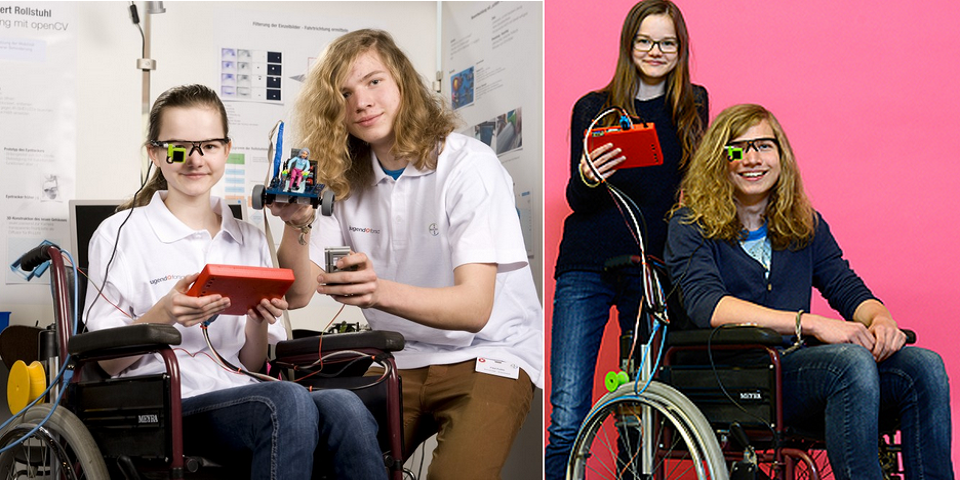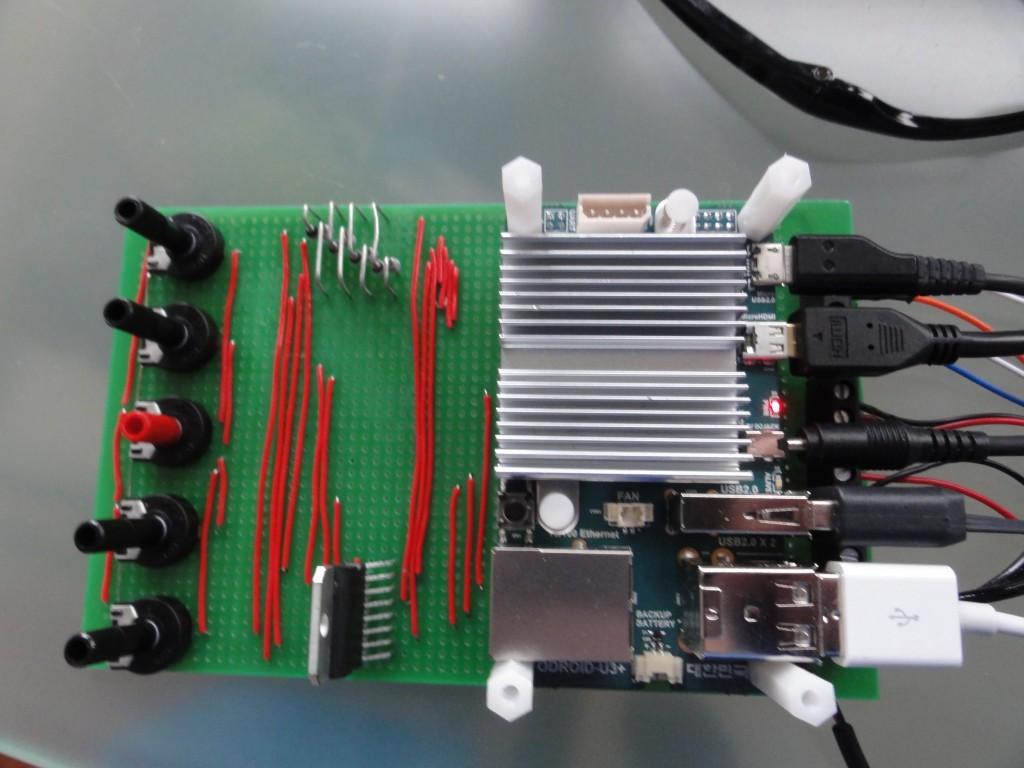Almost three years ago my mother passed away after over a twenty five year long battle with Multiple Sclerosis — a disease that left her mostly paralyzed. Although paralyzed in two legs and one  arm, she was blessed to be able to use her right hand still to operate her wheelchair up until she died. This gave her independence in a very difficult situation, but what if she couldn’t use her right hand either? Having been exposed to Multiple Sclerosis’ (and Lou Gehrig’s disease’s) potential paralyzing effects, and being a writer for 3D printing technology, I am thrilled to report that makers are tackling this difficult issue by developing a straightforward way to direct a wheelchair, using one’s eyes. And the design is a finalist in Europe’s largest youth science competition, called “Jugend forscht”, too!
arm, she was blessed to be able to use her right hand still to operate her wheelchair up until she died. This gave her independence in a very difficult situation, but what if she couldn’t use her right hand either? Having been exposed to Multiple Sclerosis’ (and Lou Gehrig’s disease’s) potential paralyzing effects, and being a writer for 3D printing technology, I am thrilled to report that makers are tackling this difficult issue by developing a straightforward way to direct a wheelchair, using one’s eyes. And the design is a finalist in Europe’s largest youth science competition, called “Jugend forscht”, too!
Meet fourteen year old, Myrijam Stoetzer, and Paul Foltin, who’s fifteen years old. They are the young makers behind this wheelchair controlled by eye movement. Stoetzer’s blog takes us through a quick summary of how the project got built and perfected as they graduated to the finals of the Jugend forscht competition. Hackaday also covers the project, as does Adafruit’s blog.
Just a brief description of how such a seemingly complex device was made. The team first designed an eyetracker using safetyglass frames, a normal webcam, and SMD-LEDs that are soldered on. The filter inside the webcam was changed to only bypass IR light to make it independent from the surrounding light conditions. So, the eye is lit up by the SMD-LEDs only. Their project developed as the competition progressed to different levels and they ended up making everything from scratch for the final competition level, including the 3D printed parts. They also relied on the brand new Raspberry Pi 2B. (The Raspberry Pi is a credit card-sized low cost computer.) This processes the video stream of the pupil’s position and compares it with adjustable preset values representing forward, reverse, left and right. The motors used were retrieved from the window washers at a car junkyard.
Once you get past the technical aspects of the project’s description you can get to the human side of how useful and important a wheelchair controlled by eye movement can be. Take, for  example, Stephen Hawking, who is one of the most renowned theoretical physicists in the world and has been wheelchair bound because of Lou Gehrig’s disease (ALS) for decades. Hawking is only able to move his eyes and a cheek muscle, and he currently uses the cheek muscle to control his wheelchair (see above photo.) Like Hawking, people who already experience paralysis or will eventually become paralyzed can live knowing they will not be dependent on others to move around in wheelchairs. This is an open source design available to all, so more and more individuals needing such a life-altering device can possibly access it more readily.
example, Stephen Hawking, who is one of the most renowned theoretical physicists in the world and has been wheelchair bound because of Lou Gehrig’s disease (ALS) for decades. Hawking is only able to move his eyes and a cheek muscle, and he currently uses the cheek muscle to control his wheelchair (see above photo.) Like Hawking, people who already experience paralysis or will eventually become paralyzed can live knowing they will not be dependent on others to move around in wheelchairs. This is an open source design available to all, so more and more individuals needing such a life-altering device can possibly access it more readily.
Stay tuned to find out how Stoetzer and Foltin do as finalists in the competition. They certainly have a bright future waiting for them as dynamic and innovative makers, and they really outdid themselves this time with their ingenious eye movement controlled wheelchair — using 3D printed parts. Let’s hear your thoughts on this design and yet another awesome use for 3D printing in the Eye Controleld Wheelchair System forum thread on 3DPB.com.
Subscribe to Our Email Newsletter
Stay up-to-date on all the latest news from the 3D printing industry and receive information and offers from third party vendors.
Print Services
Upload your 3D Models and get them printed quickly and efficiently.
You May Also Like
Top 10 3DPrint.com Stories of 2025: Kickstarter, Consumer Goods, Bankruptcy, & More
As Vanesa Listek wrote, last year was a major turning point for additive manufacturing (AM), as the industry is working to sort itself out. Customers want proven use cases and...
Stratasys’ RadioMatrix Could Mark the Beginning of the End for Cadavers in Imaging Training
Stratasys has expanded its radiopaque 3D printing material, RadioMatrix, to full commercial availability in the United States. The move could change medical imaging training by giving hospitals and researchers access...
Axtra3D Brings Full “Axtra Workflow” and New Materials to Formnext 2025
Axtra3D hits Formnext 2025 with a big shift in strategy. The company isn’t just selling printers anymore; it’s selling a complete workflow. At the show, Axtra3D unveiled its new Axtra...
Metalysis, Skyrora & Thermo-Calc to Develop Tanbium Alloy Powder for ESA-Funded Project
Metalysis is to develop Tanbium alloy powder for launch vehicle manufacturer Skyrora. Metalysis uses an FFC solid-state electrolysis process, originally developed at Cambridge University and known as the FFC Cambridge...































